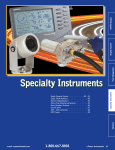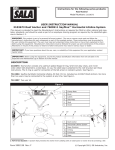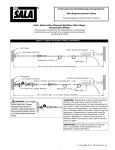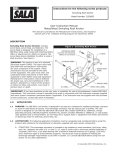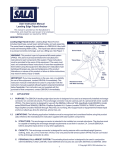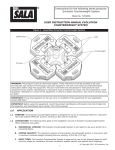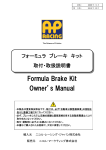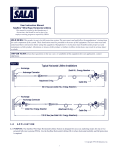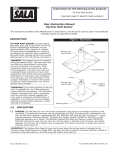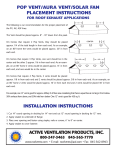Download "user manual"
Transcript
Instructions for the following series products: Tip Over Permanent Roof Anchor (See back page for specific model numbers.) User Instruction Manual Tip Over Permanent Roof Anchor This manual is provided as the Manufacturer’s Instructions, and should be used as part of an employee training program as required by OSHA. DESCRIPTION Figure 1 - Roof Anchor Tip Over Permanent Roof Anchor: Includes integral base plate, post, and D‑ring anchor. The D‑ring anchor is designed for attachment of a self retracting lifeline (SRL), lanyard, or a lifeline. The base allows installation to either wood or steel decking, using an optional rivet kit or user-supplied fasteners. When subjected to fall arrest forces, the post will tip over to reduce uplifting loads on the roof decking. See Figure 1. D-Ring Warning, Use and ID Label WARNING: This product is part of a personal fall arrest system (PFAS). The users must read and follow the manufacturer’s instructions for each component of the system. These instructions must be provided to the users of this equipment. The users must read and understand these instructions or have them explained to them before using this equipment. Manufacturer’s instructions must be followed for proper use, care and maintenance of this product. Alterations or misuse of this product or failure to follow instructions, may result in serious injury or death. Holes for Fasteners (Rivets, Fablok Fasteners, or Teks Screws) Rain Collar (Optional) 7240189 IMPORTANT: If you have questions on the use, care, or suitability for use of this equipment, contact DBI‑SALA immediately. This instruction manual is intended to be used in conjunction with the instruction manuals supplied with each system component mentioned below if applicable. If an instruction was not supplied with the purchase of that component, contact DBI‑SALA immediately. 1.0 Rivet Kit (Optional) 7240200 X 12 APPLICATION 1.1PURPOSE: The DBI‑SALA roof anchor is designed to be used as a permanently installed anchorage connector on flat roofs. This anchorage connector may be used as part of a PFAS. This roof anchor is designed for use with the DBI‑SALA Ultra-Lok® Leading Edge SRL (PN 3504500), DBI‑SALA EZ Stop and Force 2 energy absorbing lanyards, DBI‑SALA Sayfline Synthetic HLL System (models 7600502 to 7600510), or rope grabs/rope adjusters and a lifeline. The DBI‑SALA Sayfline Wire Rope HLL System (models 7602020 to 7602100) may also be used, but only when the roof anchor is fastened to the structure using the rivet kit (7240200) or Fablok Fasteners. Do not hang, lift or support tools or equipment from these roof anchors or attach guy lines for antennas, phone lines, etc. An optional rain collar (7240189) which is installed by sliding it down the post and onto the base is also available. IMPORTANT: The Sayfline Wire Rope HLL may only be used when the rivet kit (7240200) or Fablok Fasteners are used to fasten the roof anchor to the structure. Lag bolts and Teks screws do not provide sufficient strength to counteract forces generated by a fall while using the Sayfline Wire Rope HLL. © Copyright 2007, DB Industries, Inc. 1.2 LIMITATIONS: The following application limitations must be recognized and considered before using this product (also reference the manufacturer’s instruction supplied with each system component): A. STRUCTURE: This anchorage connector is intended to be installed on flat roof sheathed with ribbed steel decking or plywood. The minimum material thickness for steel decking is 22 gauge (.030 inch). The structure must be capable of meeting the anchorage strength requirements as set forth in section 2.4. The minimum thickness and material grade for plywood is 5/8 inch (1.9 cm) CDX. Consult DBI‑SALA before using this roof anchor in any other application. B.CAPACITY: This anchorage connector is designed for use by persons with a combined weight (person, clothing, tools, etc.) of no more than 310 lbs. (141 kg). Only one personal fall arrest system (PFAS) may be connected to the anchorage connector at a time. C.PERSONAL FALL ARREST SYSTEM: PFASs used with this roof anchor must meet applicable OSHA, state, federal and ANSI requirements. PFASs incorporating a full body harness must be capable of arresting a worker’s fall with a maximum arresting force of no greater than 1,800 lbs. (8 kN) [900 lbs. (4kN) maximum arresting force where used with a Sayfline Synthetic Horizontal Lifeline System] and limit the free fall distance to 6 ft (1.8 m) or less. The deceleration distance for a PFAS must be 42 inches (1.1 m) or less [47 inches (1.2 m) in Canada]. Reference ANSI Z359.1, OSHA and CSA Z259.11 requirements. If the maximum free fall distance of 6 feet (1.8 m) must be exceeded, the employer must be able to document, based on test data, that the maximum permissible arresting forces will not be exceeded, and that the personal fall arrest system will function properly. When a free fall greater than 6 ft (1.8 m) and up to a maximum of 12 ft (3.7 m) is possible, DBI‑SALA recommends using a personal fall arrest system incorporating a DBI‑SALA Force2 energy absorbing lanyard. DBI‑SALA has performed testing using the Force2 energy absorbing lanyard in free falls up to 12 ft (3.7 m) to ensure the maximum arresting force does not exceed 1,800 lbs. (8 kN), and the system functions properly. The results of these tests are listed in the user instruction manual provided with Force2 shock absorbing lanyards. D. LOCKING SPEED OF SRL: Situations which do not allow for an unobstructed fall path should be avoided. Working in very confined or cramped spaces may not allow the body to reach sufficient speed to cause the SRL to lock should a fall occur. Working on slowly shifting material such as loose shingles may not allow enough speed build-up to cause the SRL to lock. A similar situation may occur on low pitched roofs where a worker may slide instead of fall. A clear path is needed to assure positive locking of the SRL. E.CORROSION: Use near sea water or other corrosive environments may require more frequent inspections or servicing (replacement) to assure corrosion damage is not affecting the performance of the product. F.CHEMICAL HAZARDS: Solutions containing acids, alkali, or other caustic chemicals, especially at elevated temperatures may cause damage to this equipment. Consult DBI‑SALA if doubts exists concerning installing this equipment where chemical hazards are present. G.ELECTRICAL HAZARDS: Do not install the roof anchor where it or the user may come into contact with electrical power lines. H. TRAINING: This equipment must be installed and used by persons who have been properly trained in its correct application and use. Installation and use of this equipment must be supervised by a qualified person, as defined by OSHA fall protection standards. I. SHARP EDGES: Avoid working where the lifeline will be in contact with or abrade against unprotected sharp edges. 1.3 Refer to national consensus (including ANSI Z359.1), applicable local, state, and federal (OSHA) requirements governing this equipment for more information on anchorage connectors, and associated system components. 2.0 SYSTEM REQUIREMENTS 2.1COMPATIBILITY OF COMPONENTS: DBI‑SALA equipment is designed for use with DBI‑SALA approved components and subsystems only. Substitutions or replacements made with non-approved components or subsystems may jeopardize compatibility of equipment and may effect the safety and reliability of the complete system. Figure 2 - Unintentional Disengagement (Roll-out) If the connecting element that a snap hook (shown) or carabiner attaches to is undersized or irregular in shape, a situation could occur where the connecting element applies a force to the gate of the snap hook or carabiner. This force may cause the gate (of either a self-locking or a non-locking snap hook) to open, allowing the snap hook or carabiner to disengage from the connecting point. Small ring or other non-compatibly shaped element 1. Force is applied to the snap hook. 2. The gate presses against the connecting ring. 3. The gate opens allowing the snap hook to slip off. 2.2COMPATIBILITY OF CONNECTORS: Connectors are considered to be compatible with connecting elements when they have been designed to work together in such a way that their sizes and shapes do not cause their gate mechanisms to inadvertently open regardless of how they become oriented. Contact DBI‑SALA if you have any questions about compatibility. Connectors (hooks, carabiners, and D‑rings) must be capable of supporting at least 5,000 lbs. (22.2 kN). Connectors must be compatible with the anchorage or other system components. Do not use equipment that is not compatible. Non-compatible connectors may unintentionally disengage. See Figure 2. Connectors must be compatible in size, shape, and strength. Self locking snap hooks and carabiners are required by ANSI Z359.1 and OSHA and CSA Z259.12 in Canada. 2.3MAKING CONNECTIONS: Only use self-locking snap hooks and carabiners with this equipment. Only use connectors that are suitable to each application. Ensure all connections are compatible in size, shape and strength. Do not use equipment that is not compatible. Ensure all connectors are fully closed and locked. DBI‑SALA connectors (snap hooks and carabiners) are designed to be used only as specified in each product’s user’s instructions. See Figure 3 for inappropriate connections. DBI‑SALA snap hooks and carabiners should not be connected: Figure 3 - Inappropriate Connections A. To a D‑ring to which another connector is attached. B. In a manner that would result in a load on the gate. NOTE: Large throat opening snap hooks should not be connected to standard size D‑rings or similar objects which will result in a load on the gate if the hook or D‑ring twists or rotates. Large throat snap hooks are designed for use on fixed structural elements such as rebar or cross members that are not shaped in a way that can capture the gate of the hook. C. In a false engagement, where features that protrude from the snap hook or carabiner catch on the anchor and without visual confirmation seems to be fully engaged to the anchor point. D. To each other. E. Directly to webbing or rope lanyard or tie-back (unless the manufacturer’s instructions for both the lanyard and connector specifically allows such a connection). F. To any object which is shaped or dimensioned such that the snap hook or carabiner will not close and lock, or that roll-out could occur. 2.4ANCHORAGE STRENGTH: The anchorage to which the roof anchor is installed must meet minimum strength(s) as given below for the applications selected: FALL ARREST: Per ANSI Z359.1 - Anchorages selected for personal fall arrest systems (PFAS) shall have a strength capable of sustaining static loads in the direction(s) permitted by the PFAS when in use of at least (A) 3,600 lbs (16 kN) when certification exists; reference ANSI Z359.1 for certification definition), or (B) 5,000 lbs. (22.2 kN) in absence of certification. When more than one PFAS is attached to an anchorage, the anchorage strengths set forth in (A) or (B) above shall be multiplied by the number of PFAS attached to the anchorage. Per OSHA 1926.500 and 1910.66 - Anchorages used for attachment of personal fall arrest systems (PFAS) shall be independent of any anchorage being used to support or suspend platforms and capable of supporting at least 5,000 lbs (22.2 kN). per user attached, or be designed, installed and used as part of a complete PFAS which maintains a safety factor of at least two and is under the supervision of a qualified person. 3.0 OPERATION AND USAGE WARNING: Do not alter or intentionally misuse this equipment. Consult with DBI‑SALA if using this equipment in combination with components or subsystems other than those described in this manual. Some subsystems and components combinations may interfere with the proper operation of this equipment. WARNING: Consult your doctor if there is reason to doubt your fitness to safely absorb the shock from a fall arrest. Age and fitness seriously affect a worker’s ability to withstand falls. Pregnant women and minors must not use this equipment. 3.1 BEFORE EACH USE of this equipment, carefully inspect it to assure that it is in serviceable condition. Check for worn or damaged parts. Ensure the roof anchor is secure and not distorted. Inspect for sharp edges, burrs, cracks, or corrosion. Inspect other fall arrest equipment in accordance with the manufacturer’s instructions supplied with each system component. Refer to section 5.0 for further inspection details. Do not use if inspection reveals an unsafe condition. 3.2 PLAN your fall arrest system before starting your work. Take into consideration factors affecting your safety at any time during use. The following list gives some important points you must consider when planning your system: A.ANCHORAGE: Select an anchorage point that is rigid and capable of supporting the required loads. See section 2.4. Locate the roof anchor in accordance with section 3.3. B. OTHER CONSIDERATIONS: Personal fall arrest systems must be rigged to limit any free fall to a maximum of 6 ft (1.8 m) (OSHA and ANSI Z359.1). Avoid working above your anchorage level since an increased free fall distance will result. Avoid working where your line may cross or tangle with that of another worker or another object. Do not allow the lifeline to pass under arms or between legs. Never clamp, knot or otherwise prevent the lifeline from retracting or being taut, avoid slack line. Do not lengthen the SRL by connecting a lanyard or similar component without consulting DBI‑SALA. C. TOTAL FALL DISTANCE: Should a fall occur, there must be sufficient clearance in the fall area to arrest the fall before striking the ground or other object. The total fall distance is the distance measured from the onset of a fall to the point where the fall is arrested. A number of factors can influence the total fall distance including; user’s weight, anchorage location relative to the fall (swing fall), body support with sliding D‑ring, and the type of fall arrest equipment you attach to the roof anchor. For specific clearance requirements read and follow the manufacturers’s instructions for your fall arrest equipment. D. SWING FALLS: See Figure 4. Swing falls occur when the anchorage point is not directly above the point where a fall occurs. The force of striking an object while swinging (horizontal speed of the user due to the pendulum affect) can be great and may cause serious injury. Swing falls can be minimized by working as directly below the anchorage point as possible. In a swing fall situation, the total vertical fall distance of the user will be greater than if the user had fallen vertically directly below the anchorage point. The user must therefore account for an increase in the total free fall distance and the area needed to safely arrest the fall. Figure 4 - Swing Falls The SRL (if applicable) will activate (lock-up) regardless of it’s orientation and location relative to the user’s position, however, a commonly followed guideline is not to extend your work zone over 30° from the anchorage point (the roof anchor swivels providing a 30° work area on both sides of the roof anchor). Do not captivate the lifeline of an SRL, it may affect the performance of its braking. If a swing fall hazard exists in your application, contact DBI‑SALA before proceeding. E. SHARP EDGES: Avoid working where the connecting subsystem (i.e. SRL, full body harness, lanyard, lifeline, etc.) or other system components will be in contact with, or abrade against unprotected sharp edges. See Figure 5. If working with this equipment near sharp edges is unavoidable, protection against cutting must be provided by using a heavy pad or other means over the exposed sharp edge. If you are not using the Leading Edge SRL (PN 3504500), it is recommended that an energy absorber (PN 1220362) be installed inline between the harness and the self retracting lifeline to further protect the worker. Compatibility and total fall distance issues must be considered if this is done. Contact DBI‑SALA before using in-line energy absorbing components or lanyards with self retracting lifelines. Unexpected Hazards Swing Fall Hazard Figure 5 - Sharp Edges In-Line Shock Absorber PN 1220362 F.RESCUE: Should a fall occur, the user (employer) must have a rescue plan and the means at hand to implement it. G.AFTER A FALL: Any equipment which has been subjected to the forces of arresting a fall must be removed from service immediately and destroyed or contact a factory authorized service center for repair. SRL Sharp Edge Full Body Harness Roof Anchor 3.3INSTALLATION REQUIREMENTS: Figure 6 - Roof Anchor Site Plan A.ROOF ANCHOR SITE PLAN: Before starting the roof construction, a plan should be established as to where the roof anchor(s) will be installed and when, during the construction process, they may be used. See Figure 6. The following are guide lines on locating roof anchors: • This roof anchor is for use in an upright position on a horizontal surface only. • Do not install the roof anchor on unsupported roof structures such as overhangs. B.ROOF ANCHOR INSTALLATION: Roof anchors must be installed in accordance with the previously discussed site plan. Site work rules must be followed regarding when an installed roof anchor is ready for use (i.e. properly braced, etc.). C. STEEL ROOF DECKING: This anchorage connector is intended to be installed on flat roof sheathed with ribbed steel decking. The minimum material thickness for steel decking is 22 gauge (.030 inch). The structure must be capable of meeting the anchorage strength requirements as set forth in section 2.4. Consult DBI‑SALA before using this roof anchor in any other application. Models 2100070 and 2100071 are compatible with the following steel decking profiles: Type B Wide Rib, Type F Intermediate Rib, 1-1/2 inches (3.8 cm) Composite, 2 inches (5.1 cm) Composite, R Panel, Type A, Type B Inverted Form, Type S. Model 2100071 is also compatible with the following steel deck profile: Type N. he roof anchor must be fastened directly to the decking. If a roof membrane, insulation, or other T roofing material is covering the decking, this material must be removed prior to installation of the roof anchor. Position the roof anchor on the roof so two rows of holes on the base plate are located on the decking ribs. The fasteners should be located as close as possible to the center of the rib. Fasteners must not be located in the valleys between the decking ribs or on the sloped sides of the decking ribs. The roof anchor can be oriented with either the short side or the long side of the base plate being parallel to the decking ribs. ATTACHING THE ROOF ANCHOR USING RIVETS: The preferred means of fastening the roof anchor to steel decking is using DBI‑SALA part number Figure 7 - Installation 7240200, which is a rivet kit that contains twelve 12 x Rivet aluminum blind rivets with sealing washers and mastic tape to seal the fastener holes. With the Steel Decking roof anchor in position, drill three 5/16 in. diameter pilot holes in each corner of the base plate. Place a length of mastic tape over the pilot holes and place the roof anchor on the decking, aligning the holes in the decking with the holes in the base plate. Install three rivets in each corner using an appropriate riveting tool. See Figure 7. NOTE: It is helpful to fasten the base plate with a single rivet and then use the base plate as a drilling template. IMPORTANT: Twelve rivets (three in each corner) must be used to fasten the anchor. If the anchor is not installed correctly the anchor could pull away from the roof structure during a fall arrest, causing a serious injury or death. 16 x Teks Screw Steel Decking Following the installation of the roof anchor on membrane or built-up type roof construction, the insulation should be replaced and covered with a roof patch with flashing around the post of the roof anchor. An optional rain collar (DBI‑SALA part number 7240189) is available for use as part of the flashing system. ATTACHING THE ROOF ANCHOR USING SCREWS: The roof anchor may be secured using 1/4 ‑ 14 self drilling sheet metal screws (Teks screws). The screws must be 1/4 inch diameter and a length that leaves at least five full threads protruding through the decking. With the roof anchor in position, secure the base plate to the decking using 16 screws, four screws in each corner. See Figure 7. Attaching the roof anchor using fablok screws: The roof anchor may be secured using 16 Fablok Fasteners E25200 manufactured by Textron Fastening Systems to 22 gauge or thicker steel decking. This fastener installs similar to a blind rivet except a box end wrench and drill with a nut driver are used in place of a rivet tool. Without anchor in position, drill four 5/16 inch diameter pilot holes in each corner at the base plate. Place a length of mastic tape over the 16 x Lag Screw 5/8 inch CDX Plywood pilot holes and place the roof anchor on the decking. Aligning the holes in the decking with the holes in the base plate. Install four Fablok Fasteners in each corner using a box end wrench and drill with a nut driver. CAUTION: Use care when tightening self-drilling screws. If screws are over torqued the holes in the metal decking will strip out, and will not provide sufficient strength to resist fall arrest forces. IMPORTANT: Sixteen screws (four in each corner) must be used to fasten the anchor. If the anchor is not installed correctly the anchor could pull away from the roof structure during a fall arrest, causing a serious injury or death. Following the installation of the roof anchor on membrane or built-up type roof construction, the insulation should be replaced and covered with a roof patch with flashing around the post of the roof anchor. An optional rain collar (DBI‑SALA part number 7240189) is available for use as part of the flashing system. Self-drilling screws are not recommended for installations where the base plate is not covered by roofing material. D. PLYWOOD ROOF DECKING: This anchorage connector may also be installed on flat roof sheathed with plywood decking. The minimum material thickness for plywood decking is 5/8 inch (1.9 cm), grade CDX. The structure must be capable of meeting the anchorage strength requirements as set forth in Section 2.4. Consult DBI‑SALA before using this roof anchor in any other application. The roof anchor must be fastened directly to the decking. If a roof membrane, insulation, or other roofing material is covering the decking, this material must be removed prior to installation of the roof anchor. The roof anchor can be oriented in any direction on plywood decking. See Figure 7. ATTACHING THE ROOF ANCHOR USING LAG SCREWS: The roof anchor may be secured using 1/4 inch lag screws. The screws must be SAE Grade 2, 1/4 inch diameter, with a length that leaves at least five full threads protruding through the decking. With the roof anchor in position, secure the base plate to the decking using 16 screws, four screws in each corner. IMPORTANT: Sixteen screws (four in each corner) must be used to fasten the anchor. If the anchor is not installed correctly the anchor could pull away from the roof structure during a fall arrest, causing a serious injury or death. Following the installation of the roof anchor on membrane or built-up type roof construction, the insulation should be replaced and covered with a roof patch with flashing around the post of the roof anchor. An optional rain collar (DBI‑SALA part number 7240189) is available for use as part of the flashing system. Lag screws are not recommended for installations where the base plate is not covered by roofing material. E.ATTACHING LANYARDS OR LIFELINE: Once the roof anchor is secure the energy absorbing lanyard, horizontal lifeline, or rope grab/rope adjuster and vertical lifeline can be attached utilizing the D‑ring on the top of the anchor. 3.4 BODY SUPPORT: When using the DBI‑SALA swiveling roof anchor, it is recommended that a full body harness be worn. For general fall protection use, connect to the D‑ring on the back between the shoulders (dorsal D‑ring). IMPORTANT: Body belts are not allowed for free fall situations. Body belts increase the risk of injury during fall arrest in comparison to a full body harness. Limited suspension time and the potential for improperly wearing a body belt may result in added danger to the user’s health. 3.5CONNECTING TO THE ROOF ANCHOR: Figure 8 illustrates the proper connection of typical fall arrest equipment to the roof anchor. Always protect the lifeline from abrading against sharp or abrasive surfaces on the roof. Make sure all the connections are compatible in size, shape and strength. Never connect more than one personal protective system to any single roof anchor at a time. SRL: Connection to the installed roof anchor may be made by attaching the self locking snap hook at the end of the SRL lifeline to the back dorsal D‑ring (fall arrest attachment point) of the user’s body support (i.e. full body harness). When connecting, make sure the connections are fully closed and locked. Review section 3.2 if using an SRL near sharp edges. ENERGY ABSORBING LANYARDS OR LIFELINE: Connect the energy absorbing end of the lanyard to the back D‑ring on the full body harness (see section 3.4). See manufacturer’s instruction for more information. Figure 8 - Making Connections HLL SYSTEM: The tip over permanent roof anchor can be used as and end anchor for a DBI‑SALA Sayfline Synthetic HLL System (models 7600502 to 7600510). This system utilizes energy absorbers on each end to limit end loads to a maximum of 1800 lbs. (8 kN). See manufacturer’s instructions for the HLL System for more information. (Contact DBI‑SALA for more information on Sayfline Synthetic HLL systems.) The wire rope Sayfline HLL may also be used if the roof anchor is fastened to the structure using the rivet kit (7240200) or 16 Fablok Fasteners. 3.6NORMAL OPERATION: Once attached, the worker is free to move about within the recommended working areas (30° from either side of the roof anchor). SRL: Should a fall occur, a speed sensing brake system will activate, stopping the fall and absorbing much of the energy created. Sudden or quick movements should be avoided during the normal work operation since this may cause the SRL to lock-up. ENERGY ABSORBING LANYARD: Should a fall occur, the energy absorber with deploy, stopping the fall and absorbing much of the energy created. If a fall has been arrested, the system must be taken out of service and inspected, see section 5.0. WARNING: Read and follow the manufacturer’s instructions for associated equipment (i.e. SRL, full body harness, lanyard, lifeline, etc.) used in your personal fall arrest system. IMPORTANT: For special (Custom) versions of this product, follow the instructions herein. If enclosed, see attached supplement for additional instructions to be followed when using a customized product. 4.0 TRAINING 4.1 It is the responsibility of all users of this equipment to understand these instructions, and to be trained in the correct installation, use, and maintenance of this equipment. These individuals must be aware of the consequences of improper installation or use of this equipment. This user manual is not a substitute for a comprehensive training program. Training must be provided on a periodic basis to ensure proficiency of the users. IMPORTANT: Training must be conducted without exposing the trainee to a fall hazard. Training should be repeated periodically. 5.0 INSPECTION 5.1FREQUENCY: Before each use visually inspect the roof anchor per the steps listed in section 5.2 and 5.3 IMPORTANT: If this equipment has been subjected to forces resulting from the arrest of a fall, it must be immediately removed from service and destroyed or returned to DBI‑SALA for possible repair. See section 5.2. 5.2INSPECTION STEPS: Step 1. Inspect the Roof Anchor for physical damage. Look carefully for any signs of cracks, dents or deformities in the metal. If the anchor has been subjected to fall arrest forces the upright cylinder will be tipped over to one side. Do not use an anchor that has been subjected to fall arrest forces. Step 2. Inspect the Roof Anchor for signs of excessive corrosion. Step 3. Ensure the condition of the roof anchor will support the Roof Anchor loads, see section 2.4. An anchor connected to rotten or deteriorated wood should not be used. Step 4. Check all fasteners. Ensure the Roof Anchor is securely attached to the roof structure. See section 3.3. Step 5. Inspect each system component or subsystem (i.e. SRL, full body harness, lanyard, lifeline, etc.) per associated manufacturer’s instructions. Refer to manufacturer’s instruction supplied with each system component for inspection procedures. Step 6. Record the inspection date and results in the inspection log. See section 9.0. 5.3 If inspection reveals a defective condition, remove the unit from service immediately and destroy, or contact a factory authorized service center for repair. IMPORTANT: Only DBI‑SALA or parties authorized in writing may make repairs to this equipment. 6.0 MAINTENANCE - SERVICING - STORAGE 6.1 Clean the roof anchor with a mild soap detergent solution. If you have any questions concerning the condition of your roof anchor, or have any doubt about putting it into service, contact DBI‑SALA immediately. Refer to the manufacturer’s instructions supplied with each system component for maintenance, servicing, and storage procedures. 6.2 Additional maintenance and servicing procedures (i.e. replacement parts) must be completed by a factory authorized service center. Authorization must be in writing. 7.0 SPECIFICATIONS 7.1COMPONENTS: MATERIALS: Carbon steel base plate and post, alloy steel D‑ring FINISH: Powder paint over phosphate coating, zinc-plated D‑ring WEIGHT: 2100070:12 lbs. (5.4 kg) 2100071: 14 lbs (6.3 kg) SIZE: 2100070 Base: 14 in. x 16 ½ in. (35.6 cm x 41.9 cm) Height to top of D‑ring: 12 ½ in. (31.8 cm) 2100071 Base: 14 in. x 20 ½ in. (35.6 cm x 52.1 cm) Height to top of D‑ring: 12 ½ in. (31.8 cm) CAPACITY: 310 lbs. (141 kg) (one person) MINIMUM BREAKING STRENGTH: 5,000 lbs. (22.2 kN) when secured with 7240200 rivet kit or 16 Fablok Fasteners. 3,600 lbs. (16 kN) when secured with self drilling or lag screws. 8.0 LABELING 8.1 This label should be securely attached to the roof anchor and fully legible. See applicable manufacturer’s instructions for subsystem components’ labels. Warning, Use and ID Label 10 9.0 inspection and maintenance log Date of manufacture model number date of purchase Inspection date inspection items noted corrective action Approved by: Approved by: Approved by: Approved by: Approved by: Approved by: Approved by: Approved by: Approved by: Approved by: Approved by: Approved by: Approved by: Approved by: Approved by: Approved by: Approved by: Approved by: Approved by: 11 maintenance performed This instruction applies to the following models: 2100070 2100071 Additional model numbers may appear on the next printing of these instructions A Capital Safety Brand USACanada 3833 SALA Way 260 Export Boulevard Red Wing, MN 55066-5005 Mississauga, Ontario L5S 1Y9 Toll Free: 800-328-6146 Toll Free: 800-387-7484 Phone: (651) 388-8282 Phone: (905) 795-9333 Fax: (651) 388-5065 Fax: (905) 795-8777 www.capitalsafety.com www.capitalsafety.com This manual is available for download at www.capitalsafety.com. I S O 9001 Certificate No. FM 39709 12 Form: 5902258 Rev: C













